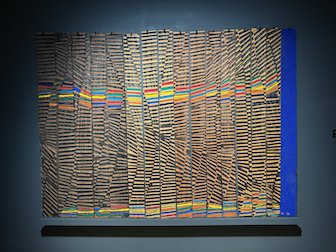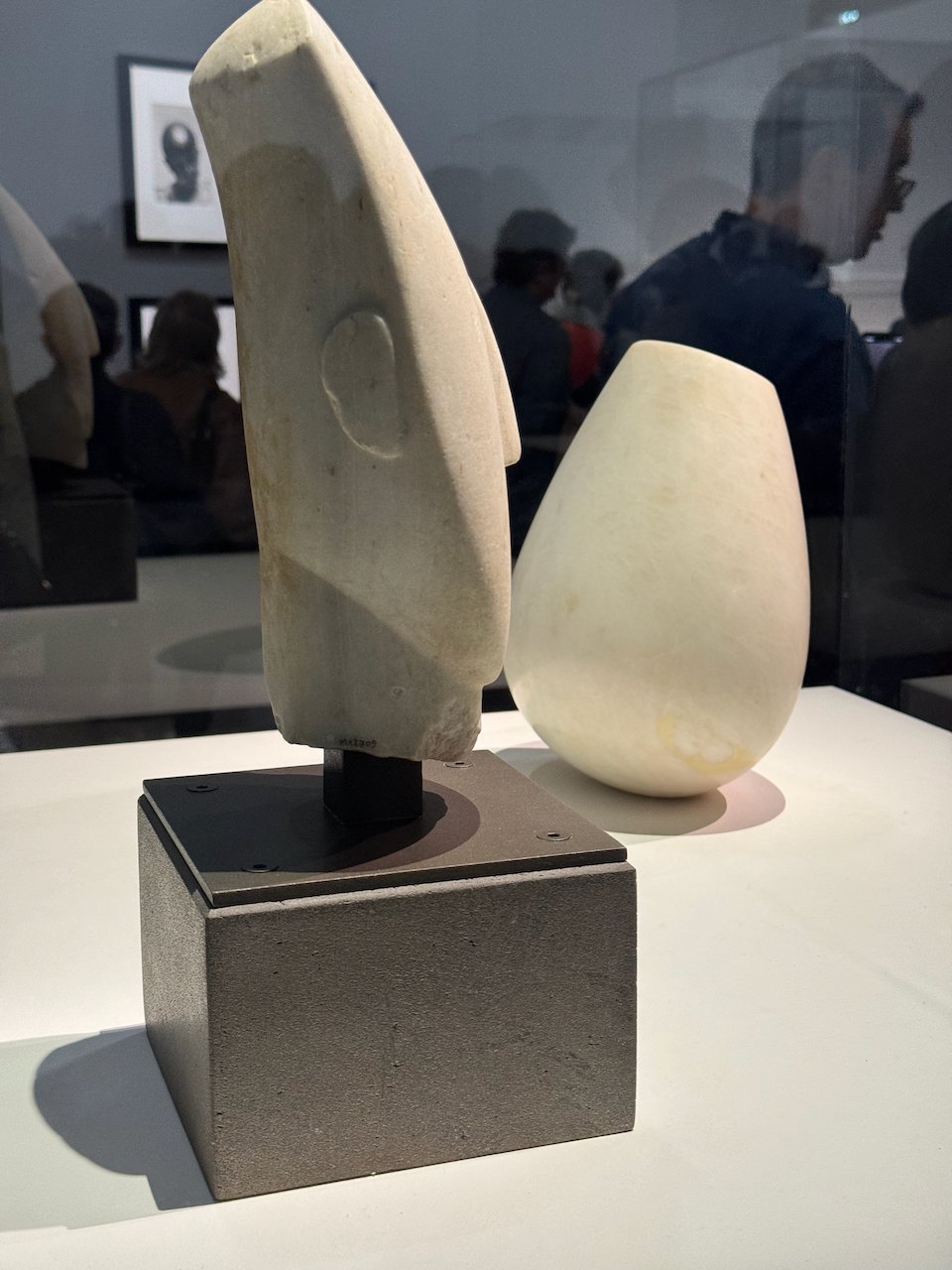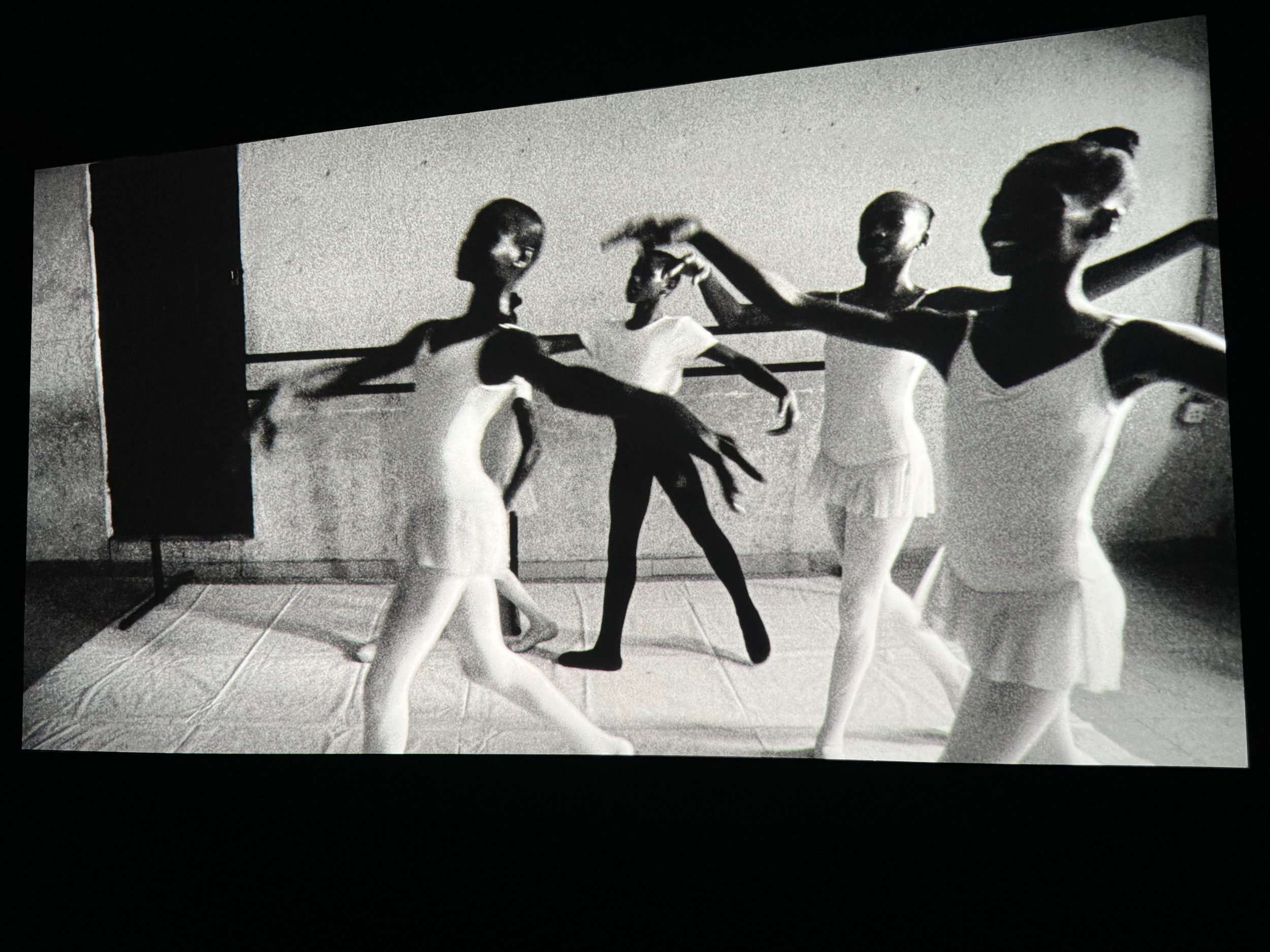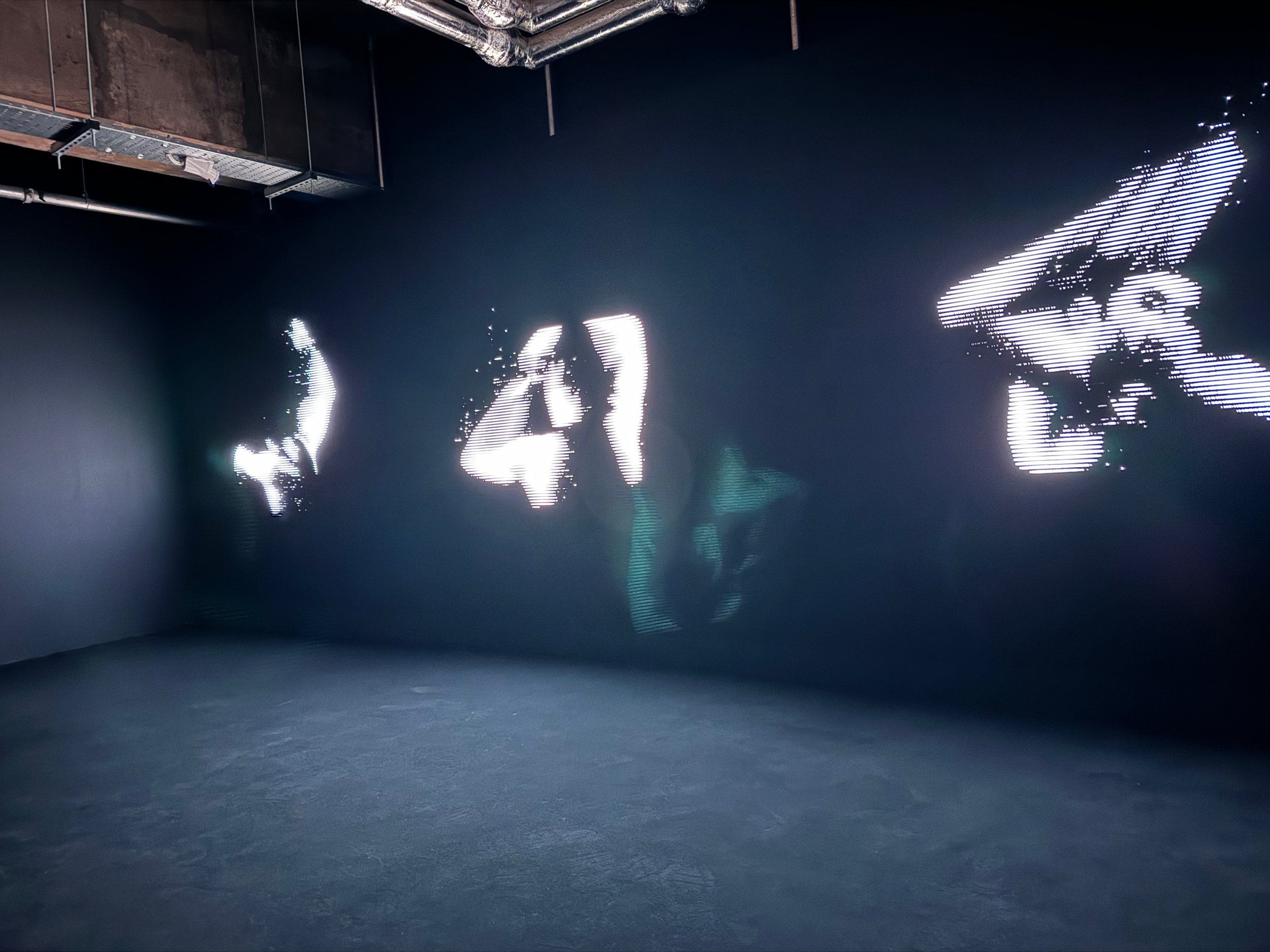I am intrigued by the work of Jesse Jones, who describes herself a multimedia artist across film, performance, and installation. I saw a recent work at the Ikon Gallery in Birmingham(Mirror Martyr Mirror Moon, 2024): an immersive shrine-like darkened space featuring a video of a soprano singing songs from the 17th century (Monteverdi and Caccini) and accompanied by several sculptures maybe posing as relics, and a performative moving scrim curtain. The video was sensuous, blood-red, and silver, using the placement of mirrors to the reflect cascading images (and voices) of the singer. The installation was a commission centered on a loaned work by Artemisia Gentileschi which was also spotlit in the space. The disparate parts of the installation didn't work together for me. The placement of the items in relation to each other was intentional but hard to fathom without the written explanation. The intent overall was intriguing. The femininity in the video was palpable. The tactile moment with the curtain (if close enough) was a nice surprise.
Symbols and stories
An exhibit of El Anatsui’s work spanning four decades was on display at the University of Edinburgh (Talbot Rice Gallery). The opening rooms featured his sculptural tapestries of made of disarded bottletops, alluding to colonial trade flows in West Africa. There were also woodcuts and prints, with collage, chine-collé, silver and gold foil. A bifurcated experience: beauty, at least from a distance, but disturbing symbolism in the materials up close.
Archival intermediaries
I want to experiment with mixing archives and shot footage to tell stories that are only loosely narrative in structure. One artist who does this is John Akromfah. I managed to watch his most famous work Vertigo Sea in London recently.
He was interviewed there about the creative process for his new installation at the British pavilion in the 2024 Venice Biennale. As he pondered the commission he said he thought a lot about the meaning of the space he was showing in, asking what are the phantoms from his perspective and how do you transform an iconic space to create a feeling of adding, not desecration. At some point, he said, the work in progress develops its own language through symbols, narratives, palettes for visuals and sound etc. But he chose to make the entrance to the show from basement to "get rid of imperial baggage of entrance".
He talked about the sonic being a big part of his work, because "sonic can dethrone the visual." In the Venice show he displays a quote from Pauline Oliveras: "Listen to everything until it all belongs together and you are part of it." He said these days he is more interested in "clothing archival in different garments." Perhaps looking for new language he says we currently try think too much of archive as time-based. So one room in the Venice pavilion uses sound archives and he fills the space with devices that these sounds might have been heard on, such as radios. These devices come with new stories and potential resonances.
How to create a trace of essence?
How imperceptible can the “essence” be and still be the essence? I saw a marvellous exhibit of the almost imperceptible in the form of Brancusi sculptures at the Pompidou Centre recently. The gallery space set off his work beautifully. Perhaps the most stunning vision was his bird sculptures set against floor to ceiling windows revealing the sky and the cityscape of Paris. Apparently influenced by Clycladic (first image) and African art, his sculptures of female heads were the most beautiful. Another very striking element is the plinths, often rough in texture and the antithesis of the main sculptural work.
Fixation with texture
Richard Serra’s steel sculptures had the most wonderful textures. Some late paintings had a similar fixation - here paint stick on hand made paper. And a very nice biopic piece in New Yorker from 2002 here.
Caravaggio
Martyrdom of Saint Ursula has wonderful shadow and light. I’d like to create this look in film. Almost surreal.
Immersive, interactive, multimedia
At the 180 Strand show mentioned in the last post two other works were of interest for interactivity. One called “Screenshare” by Es Devlin (first 2 images), creates a cinema screen out of recreations of her sketch book pages. Visitors can pull off a page and take it away. The other by Hito Steyerl called “This is the Future” explores a futuristic garden. In the sequence as I viewed it, first was a cinema screen with beautiful images, which soon became transparent revealing several sculptures of digital flower screens behind. You could walk behind the cinema screen and amongst the flower sculptures, rather like entering an image.
Soundscapes
180 Strand has a show featuring artist collaboration commissions from the Vinyl Factory. The stand out for me was a short film called Ijó by Gabriel Moses. Beautiful very grainy atmospheric images grain, mostly in black and white, with a mesmerizing sound track of voices instruments with “ambient location sound” but placed sonically at a distance. The sound held the work together.
The film followed some young ballet dancers in Lagos. The director said the film was inspired by old black and white family photos and artists such as American Gordon Parks and Malian photographer Malick Sibibé
AI and art
I watched a recent webinar/conversation on AI and art with Marco Brambilla, hosted by RCA London. Brambilla said he uses AI now for researching and sketching projects. It saves time and money. But says the more specific you want the results to be, the harder it is, because AI is trained on “average”. Right now, he said, you see the limitations clearly.
He says film is now becoming more about spectacle. Narrative and dialogue are being removed and the result is very abstract. He argues that you have to be open to looking at something which doesn’t have a story. Someone asked about the soulessness of AI generated media. He said we are already in a media landscape that has lost the “organic” and "you can see it as a renaissance or apocalyptic."
Nude Descending a Staircase No. 3, Screenshot, https://marcobrambilla.com/NudeDescendingaStaircase The installation was placed in a new transport hub building in New York, designed by Santiago Calatrava.
Extraction
The Saatchi Gallery is featuring photos and videos by Edward Burtynsky. I was impressed many years ago with a documentary film he collaborated on called “Manufactured Landscapes.” This show is a retrospective of his photography work: distressing environmental havoc images that are both beautiful and repulsive. Below images show diamond mining tailings/residue in Kimberly, South Africa, gold mining tailings/residue in Johannesburg, and salt mining in Senegal.
Burtynsky’s multiscreen video/photo installation compiling images from his entire career, was also striking. What worked less well in the installation: zooming and panning on multiple images at the same time; both the lack of story in some segments, and the lack of subtly in the story at other times. So easy to be too didactic. The music soundscape was too aggressive in telling you what to feel.
Refreshing sensibility
The Barbican has a beautifully curated show about power and politics in textile art. A refreshing, clever, and revealing assertion of a mostly feminine sensibility. Most striking were Cecilia Vicuña (Quipu Austral, 2012), South African artist Igshaan Adams (Prayer Clouds, 2021-23), and Magdalena Abakanowicz (Vêtement Noir, 1968). Vicuña’s work is long lengths on unspun wool, swaying gently to the sound of chanted poems about water. Quipu is a knot (Andean) and a system of communicating with the cosmos which was banned by the Spanish colonisers. Adams takes us on a walk through dusty borderlands - in this case between segregated towns. Abakanowicz’s work is made of sisal iron and horse hair. The Polish artist said she found traditional textiles a way to escape government surveillance of the arts and as a result a place for experimentation. Each work comes with a detailed story.
Eye food not soul or brain food
At Serpentine there’s some immersive AI video works by Rafik Anadol. He is an early mover in using AI for art on a grand scale. There are 3 projects, though working out their boundaries in the gallery is hard, as is distinguishing the project names. The gallery describes one project Living Archive: Large Nature Model, which trained on images from the Smithsonian, National Geographic, and London’s Natural History Museum (Artnet February 15, 2024) in this way:
“The installation wraps the gallery walls in AI generated images inspired by data of flora, fungi and fauna from over 16 rainforest locations globally, which was collected using technologies such as LiDAR and photogrammetry.”
Beautiful or banal? The artist’s recent work at MOMA (Unsupervised, 2022), was a nice antidote to hours of cruising the collection, but as a standalone piece it felt like spectacle. Is that enough? Is it art? It’s described in the show as the nexus of art, technology and nature. First steps towards something very new? Below: Artificial Realities: Coral, “highlighting the role of coral reefs.”
Less is more again
A show at Kew by Matt Collishaw apparently takes a look at the changing role of technology, art and nature. Spectacle, not subtle. His calibrations of image and sound and movement leave little work for the imagination, and the work does not endure for me.
The way we think now - or less is more
I’m interested in how we need to find structure, create names, write theories, and tell stories to be at ease with the world around us. An exhibition by United Visual Artists at 180 Strand apparently is in this vein. The work of UVA is said to reflect “the cultural frameworks and symbolic systems that shape and govern our reality.” The works in this show, called Synchronicity, are collaborations with artists across media. The captions are a bit pretentiously detailed about what the art represented, as if the curator is not confident a meaning will emerge. Less might have been more. Overall the works felt soul-less. More engineering than art. Maybe that was the point.
The first image is Present Shock II: “Juxtaposing life-changing global events with with the banal trivia of everyday existence, the work is a manifestation of the “context collapse that defines our present moment, disrupting our sense of time, coherence, narrative and consensus reality.” [from the wall caption]
The second, Ensemble, is a reflection on human gesture and innate musicality and how this changes over time. It was the most visually interesting, the least coherently explained, and therefore the most ambiguous, in my view. I did like the way the images looked pixelated and as if disintegrating.
The third image is Chromatic exploring the interaction of form, color and sound. A piano composition filled the room while colors and images flashed by on a wall sized screen.
The fourth is Music Universalis a kind of music of the spheres in smokey blue light.
Conceptual art and the Anthropocene
A new show I must see soon - at Kew Gardens - investigating the relationship between art, nature and technology, in different media (film, photo, AI, NFT. The reviewer of the show called Petrichor by Mat Collishaw says: “Petrichor is a visual extravaganza with a mind and a heart. Most eco-shows are grave and preachy. Collishaw’s is conceptual art at its most rewarding: curious, inventive and fun.” Sounds right up my alley but we will see.































































